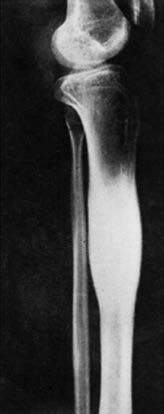Sclerosing osteomyelitis, also known as Garré osteomyelitis, is a form of chronic osteomyelitis caused by low-virulence bacterial infection, characterized primarily by bone sclerosis. This condition most commonly affects the femur and tibia.
Systemic symptoms are typically absent, with local intermittent pain being the main complaint. Patients often experience dull pain when standing for prolonged periods, which may worsen with walking or exertion, and occasional nighttime pain may occur. Acute exacerbations are sometimes observed when the body's immune resistance is weakened, presenting with localized pain and increased skin temperature. However, redness, swelling, or skin ulceration is rare.
Laboratory tests show no specific abnormalities. X-ray imaging may reveal localized or extensive bone hyperplasia and sclerosis in the diaphysis, with findings such as cortical thickening, increased bone density, narrowed or obliterated medullary cavities, and indistinct borders between the sclerotic and healthy bone. The diaphysis may appear fusiformly thickened, without periosteal reaction. Small radiolucent areas may occasionally be seen within the sclerotic bone.

Figure 1 Thickening of the cortical bone in the middle-upper tibial diaphysis, with increased bone density and an obliterated medullary cavity.
During acute episodes, systemic antibiotic therapy can alleviate pain. Due to the sclerotic nature of the affected bone, which impairs blood circulation, antibiotics have difficulty reaching the lesion, and surgical treatment is often required. Surgery is performed after the acute episode has been controlled. The procedure involves thinning the thickened cortical bone, creating an opening (fenestration), thoroughly debriding the lesion, adequately decompressing the area, and placing drainage tubes before the incision is closed. Antibiotic-loaded bone cement bead chains may also be placed within the medullary cavity and gradually removed within two weeks after surgery. Postoperatively, systemic antibiotic therapy is routinely employed.